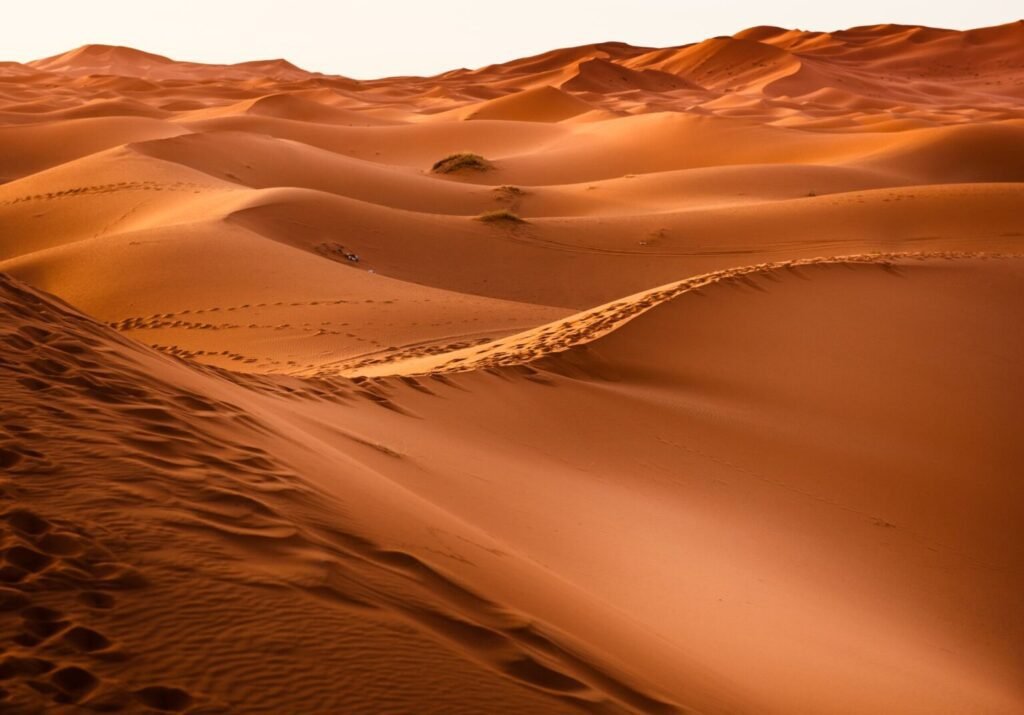

Pic Courtesy : Riyadh.com
The Red Sands, locally known as “Al Riyadh Al Hamra,” are located approximately 50 kilometers southeast of Riyadh, the capital city of Saudi Arabia. This vast desert expanse covers an area of about 10,000 square kilometers, stretching across the eastern edge of the Tuwaiq escarpment.
The distinctive red color of these sands is attributed to their high iron oxide content. Geologists believe that the Red Sands formed over millions of years through the erosion of sandstone formations. Wind and water have played crucial roles in shaping the landscape, creating the rolling dunes we see today.
The sand in this region is notably fine and soft, with a vibrant reddish-orange hue that intensifies during sunrise and sunset. This unique coloration, combined with the ever-changing patterns created by the wind, makes the Red Sands a visually striking and dynamic landscape.
The Red Sands area has been an important part of ancient trade routes, particularly the incense trade that connected Arabia with Mesopotamia and the Mediterranean. Caravans traversed these sands, leaving behind artifacts and stories that archaeologists continue to uncover.
For centuries, the Bedouin people have called the Red Sands home. Their nomadic lifestyle, adapted to the harsh desert environment, has shaped a rich cultural heritage. Traditional practices such as falconry, camel herding, and tent weaving are still preserved and celebrated in the region.
Today, the Red Sands serve as a vital natural landmark and tourist attraction. They play a significant role in Saudi Arabia’s efforts to diversify its economy through tourism, offering visitors a glimpse into the country’s natural beauty and cultural history.
Despite the challenging environment, several plant species thrive in the Red Sands. These include drought-resistant shrubs like the Calligonum comosum and the Haloxylon salicornicum. These plants have developed remarkable adaptations, such as deep root systems and small, waxy leaves to conserve water.
The Red Sands ecosystem supports a variety of desert-adapted wildlife. Species such as the Arabian oryx, sand gazelle, and red fox can be found in the area. The desert is also home to numerous bird species, including the hoopoe lark and the Arabian babbler.
Conservation initiatives are underway to protect the unique biodiversity of the Red Sands. The Saudi Wildlife Authority has implemented programs to monitor and preserve endangered species, while also working to restore habitats affected by human activities.
The Red Sands offer exciting opportunities for dune bashing and off-road driving. Experienced guides lead tours in 4×4 vehicles, allowing visitors to experience the thrill of navigating the steep dunes while enjoying panoramic views of the desert landscape.
For a more traditional desert experience, camel rides and guided safaris are available. These tours often include visits to Bedouin camps, where visitors can learn about local customs and enjoy traditional Arabian hospitality.
The Red Sands provide an ideal setting for overnight camping adventures. The clear desert sky offers exceptional stargazing opportunities, with minimal light pollution allowing for unobstructed views of the night sky.
The Red Sands, like many desert ecosystems, face challenges related to climate change. Increasing temperatures and changing precipitation patterns may affect the delicate balance of the desert ecosystem, potentially impacting both flora and fauna.
The proximity of the Red Sands to Riyadh has led to increased human activity in the area. Off-road driving, littering, and urban expansion pose threats to the natural environment and wildlife habitats.
Efforts are being made to promote sustainable tourism in the Red Sands. These include designated driving areas, educational programs for visitors, and the development of eco-friendly accommodations that minimize environmental impact.
The Red Sands offer photographers a wealth of opportunities to capture stunning landscapes. The interplay of light and shadow on the dunes, especially during the golden hours of sunrise and sunset, creates captivating images.
The unique beauty of the Red Sands has inspired many local artists. The desert landscape is often depicted in paintings, sculptures, and traditional crafts, reflecting its cultural significance to the region.
The best times for photography in the Red Sands are during the early morning and late afternoon when the low angle of the sun enhances the sand’s rich colors and creates dramatic shadows. The winter months, from November to February, offer milder temperatures and clearer skies, ideal for photography.
The Red Sands of Riyadh offer a unique blend of natural beauty, cultural heritage, and adventure. From its geological formation to its historical significance and modern-day recreational opportunities, this desert landscape continues to captivate visitors and play an important role in Saudi Arabia’s natural and cultural tapestry. As we appreciate its beauty, it’s crucial to support conservation efforts and sustainable tourism practices to preserve this remarkable ecosystem for future generations.
FAQs and answers
- Q: When is the best time to visit the Red Sands?A: The best time to visit is during the cooler months from November to February when temperatures are more comfortable for outdoor activities.
- Q: Are guided tours available in the Red Sands?A: Yes, numerous tour operators offer guided experiences, including dune bashing, camel rides, and overnight camping trips.
- Q: Is it safe to explore the Red Sands independently?A: While possible, it’s recommended to explore with a guide or tour group, as the desert environment can be challenging and potentially dangerous for inexperienced visitors.
- Q: What should I bring for a day trip to the Red Sands?A: Essential items include plenty of water, sun protection (sunscreen, hat, sunglasses), comfortable clothing, and sturdy shoes.
- Q: Are there accommodations available in the Red Sands?A: While there are no permanent hotels in the desert itself, there are camping options and nearby resorts that offer desert excursions.
